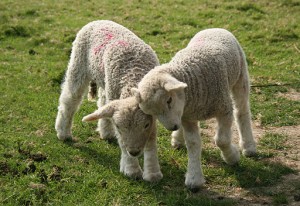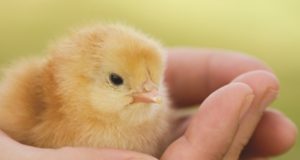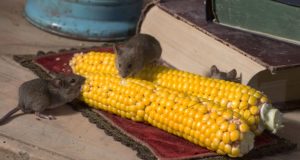 Keeping sheep on your homestead or farm is no small undertaking. They require good housing to protect them from the elements, vaccinations, feed, and regular care. They need to be sheared each year, and when lambing time comes around, you will have to supervise and care for the babies as needed. The payback, though, can be great. Sheep are an excellent source of wool and meat. You can use the wool yourself or sell it for income. You can also sell the lambs for extra money and slaughter sheep to feed your family.
Keeping sheep on your homestead or farm is no small undertaking. They require good housing to protect them from the elements, vaccinations, feed, and regular care. They need to be sheared each year, and when lambing time comes around, you will have to supervise and care for the babies as needed. The payback, though, can be great. Sheep are an excellent source of wool and meat. You can use the wool yourself or sell it for income. You can also sell the lambs for extra money and slaughter sheep to feed your family.
Before your first lambing, be sure you are as informed as you can be about the process and how to care for the newborns. It would be especially beneficial to have someone there who has experience with sheep to help you through the process for the first time. Around 20 percent of lambs die before they are weaned. If you take the time to learn about their care and then put it into action, you can reduce this statistic significantly, at least on your homestead.
Successfully Raise Farm Animals With The Backyard Homestead Guide…
Preparation
Healthy lambs start with healthy ewes. Nutrition during gestation is essential for the health of the ewe and the lambs. She will need more energy than usual, so it is important to make sure the ewe is getting enough feed. A balance must be struck between under and over feeding the ewe. Both extremes can result in problems in the lambs. A good measure is to give her one and a quarter to one and a half pounds of concentrated grain along with three and a half to four pounds of hay. Pregnant ewes should be fed separately from the other sheep and should never be given their feed on the ground.
Your pregnant ewe will also need to get adequate vitamin E, selenium, and calcium. If necessary, give her a supplement. She may be most at risk of calcium deficiency if most of her food comes from grains. Foraged feed has more calcium. In addition to nutrients, your ewe needs to get plenty of exercise. Place water, feed, and minerals far apart from each other so she has to move around. Minimize her stress by handling her as little as possible. Check with your veterinarian to see what vaccinations she should have before lambing.
Once you are sure the ewe is in good condition for lambing, it’s time to be sure the facilities are in order. The lambing area in the barn should be cleaned thoroughly as well as limed. Some people like to put down a layer of diatomaceous earth to soak up excess moisture, which keeps the location more sanitized. Lastly, put down fresh bedding. The area for lambing should be twelve to fourteen square feet per ewe. Be sure the area is warm and free of drafts.
You will also need to prepare the lambing jugs. These are the pens to which you will move the ewe and lamb after birthing. These small pens help the lamb and ewe to bond and prevent mismothering. They should be cleaned as thoroughly as the lambing area before the animals are moved in. Create a little nook in one corner of the jug that is divided off from the rest of the space. This gives the lamb a safe place where it can retreat for safety reasons.
After Lambing
One of the first things that you will need to do to keep your new lambs healthy and safe is disinfect their navel cords. These are a sure way for infection to get into the lamb’s body and should be dealt with right away. First, clip the cord so that it is no longer than two inches. Then, disinfect the stump with an appropriate solution such as gentle iodine or betadine. Either spray the stump or dip it in the iodine solution.
Your lamb’s first food should be its mother’s milk. The first milk that she produces after giving birth is called colostrum, and it is very important that the lamb gets it within the first twenty-four hours. It is possible for a lamb to survive without it, but the risk is great that it will die of a disease. Colostrum is so important because in addition to containing crucial nutrients, it has antibodies that will protect the lamb from infection and disease. The ewe produces these antibodies, but does not pass them through the placenta to the lamb. For this reason, the newborn lamb is extremely vulnerable. To get the needed antibodies, it must consume them through the colostrum. If for some reason the ewe is not producing enough or will not feed the lamb, you can use replacement colostrum from another ewe or from a cow or goat. A lamb should get about a pound of colostrum in the first twenty-four hours, and another half of a pound eight hours after that.
Until your lamb is big and healthy, you must do all that is possible to avoid the main causes of death. These include starvation, hypothermia, scours (diarrhea), and pneumonia. Ensuring an adequate intake of colostrum is the first step towards preventing untimely death. It even helps to keep the newborn lamb warm. Additionally, preparing the lambing area and jug correctly will help to ward off dangerous chills. The ewe’s care for the lamb is also important. The faster she licks off the newborn, the warmer it will be. Watch the lamb’s behavior for signs of hypothermia: hunching up, unable to hold up its head, cold feel to its mouth and ears, and an inability to suckle. Its temperature should not drop below 100 degrees Fahrenheit. You can warm up a cold lamb by making sure it is dry, wrapping it in a blanket, and getting it enough colostrum.
To prevent starvation of your lamb, be sure that it is suckling and that its mother is producing enough milk. An underfed lamb will either be unable to stand or will stand with its head drooping down. It will also become hypothermic as a result of not getting enough nourishment. Starvation is a bigger risk in the first three days. You may need to bottle feed your lamb if it is not getting enough from the mother.
Scours, or diarrhea, can be very deadly in your baby lamb. It is caused by various types of bacteria, and the infection can be prevented by getting the lamb an adequate amount of colostrum. Preparing the lambing area and jug by cleaning and disinfecting is also good protection against scours. If you find yourself with a case of scours, you can treat it. You will need to administer antibiotics and fluids to the lamb.
The final concern for your newborn’s safety, pneumonia, is also caused by a bacterial infection. Again, getting an adequate intake of colostrum and proper disinfection are key. Keeping out drafts and moisture while ensuring good ventilation is also important. A lamb with pneumonia will have a fever, an increased breathing rate, will be lethargic and gaunt, and may not be feeding correctly. To treat an infection, you must administer penicillin, tetracycline, or other antibiotics. Giving the lamb fluids at the same time can make the treatment more successful.
In the event that your new lamb is rejected by its mother, you will either need to care for it yourself or foster it to another ewe. If you had multiple births, you can first try giving the lamb to a different mother. To encourage her to accept it, try rubbing her placenta on the newborn. Be prepared with replacement colostrum in case she will not take the baby and you need to bottle feed it.
Caring for lambs is all about getting through the first ten days or so. If you can ensure the lamb gets enough colostrum, is warm, well fed, and disease free at this point, you are nearly home free. Once they pass the crucial stage, lamb care is largely hands-off. As long as their mother accepts them, the lambs will be happy and healthy and you will have new additions to your herd.
©2012 Off the Grid News
 Off The Grid News Better Ideas For Off The Grid Living
Off The Grid News Better Ideas For Off The Grid Living




